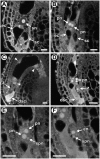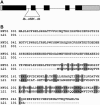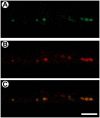NUCLEAR FUSION DEFECTIVE1 encodes the Arabidopsis RPL21M protein and is required for karyogamy during female gametophyte development and fertilization
- PMID: 16698901
- PMCID: PMC1489897
- DOI: 10.1104/pp.106.079319
NUCLEAR FUSION DEFECTIVE1 encodes the Arabidopsis RPL21M protein and is required for karyogamy during female gametophyte development and fertilization
Abstract
Karyogamy, or nuclear fusion, is essential for sexual reproduction. In angiosperms, karyogamy occurs three times: twice during double fertilization of the egg cell and the central cell and once during female gametophyte development when the two polar nuclei fuse to form the diploid central cell nucleus. The molecular mechanisms controlling karyogamy are poorly understood. We have identified nine female gametophyte mutants in Arabidopsis (Arabidopsis thaliana), nuclear fusion defective1 (nfd1) to nfd9, that are defective in fusion of the polar nuclei. In the nfd1 to nfd6 mutants, failure of fusion of the polar nuclei is the only defect detected during megagametogenesis. nfd1 is also affected in karyogamy during double fertilization. Using transmission electron microscopy, we showed that nfd1 nuclei fail to undergo fusion of the outer nuclear membranes. nfd1 contains a T-DNA insertion in RPL21M that is predicted to encode the mitochondrial 50S ribosomal subunit L21, and a wild-type copy of this gene rescues the mutant phenotype. Consistent with the predicted function of this gene, an NFD1-green fluorescent protein fusion protein localizes to mitochondria and the NFD1/RPL21M gene is expressed throughout the plant. The nfd3, nfd4, nfd5, and nfd6 mutants also contain T-DNA insertions in genes predicted to encode proteins that localize to mitochondria, suggesting a role for this organelle in nuclear fusion.
Figures







References
-
- Alexander RW, Cooperman BS (1998) Ribosomal proteins neighboring 23 S rRNA nucleotides 803-811 within the 50 S subunit. Biochemistry 37: 1714–1721 - PubMed
-
- Choi Y, Gehring M, Johnson L, Hannon M, Harada JJ, Goldberg RB, Jacobsen SE, Fischer RL (2002) DEMETER, a DNA glycosylase domain protein, is required for endosperm gene imprinting and seed viability in Arabidopsis. Cell 110: 33–42 - PubMed
Publication types
MeSH terms
Substances
Associated data
- Actions
- Actions
LinkOut - more resources
Full Text Sources
Other Literature Sources
Molecular Biology Databases

